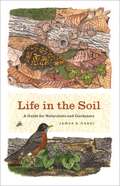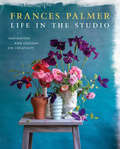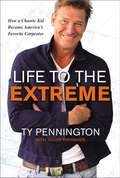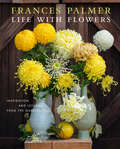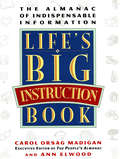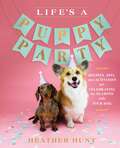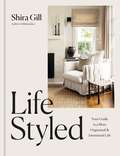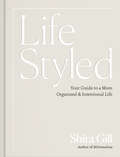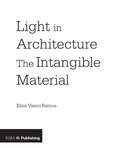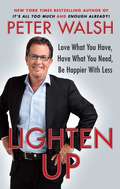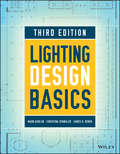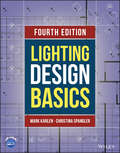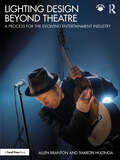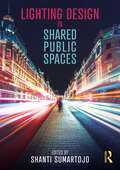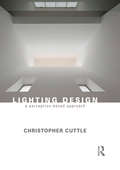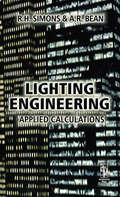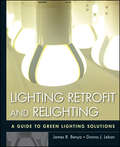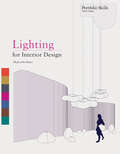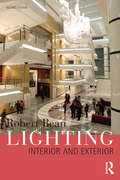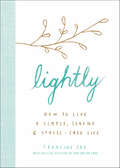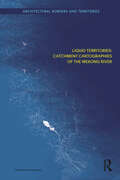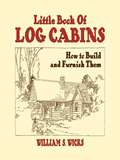- Table View
- List View
Life in the Soil: A Guide for Naturalists and Gardeners
by James B. NardiLeonardo da Vinci once mused that "we know more about the movement of celestial bodies than about the soil underfoot," an observation that is as apt today as it was five hundred years ago. The biological world under our toes is often unexplored and unappreciated, yet it teems with life. In one square meter of earth, there lives trillions of bacteria, millions of nematodes, hundreds of thousands of mites, thousands of insects and worms, and hundreds of snails and slugs. But because of their location and size, many of these creatures are as unfamiliar and bizarre to us as anything found at the bottom of the ocean. Life in the Soil invites naturalists and gardeners alike to dig in and discover the diverse community of creatures living in the dirt below us. Biologist and acclaimed natural history artist James B. Nardi begins with an introduction to soil ecosystems, revealing the unseen labors of underground organisms maintaining the rich fertility of the earth as they recycle nutrients between the living and mineral worlds. He then introduces readers to a dazzling array of creatures: wolf spiders with glowing red eyes, snails with 120 rows of teeth, and 10,000-year-old fungi, among others. Organized by taxon, Life in the Soil covers everything from slime molds and roundworms to woodlice and dung beetles, as well as vertebrates from salamanders to shrews. The book ultimately explores the crucial role of soil ecosystems in conserving the worlds above and below ground. A unique and illustrative introduction to the many unheralded creatures that inhabit our soils and shape our environment above ground, Life in the Soil will inform and enrich the naturalist in all of us.
Life in the Studio: Inspiration and Lessons on Creativity
by Frances Palmer&“Roll-up-your-sleeves advice on throwing pottery, growing dahlias, cooking her tried-and-true recipes, and everything in between.&”—Martha Stewart Living&“Guaranteed to, as its title insists, inspire. . . . Demands to be viewed again and again and again.&” —Booklist, starred review To step into potter Frances Palmer&’s world is to be surrounded by the trappings of a life that has been intentionally—and painstakingly—built to maximize creativity. A light-filled, airy studio in which to make her pottery, with a corner always at the ready for her daily photo shoots. Cutting gardens overflowing with flowers to be snipped as inspiration strikes. Shelves of cookbooks to peruse as she plans the menu of her next dinner party, and museum catalogs and art books to pore over when it&’s time to imagine a new vessel. After 30 years as an artist and entrepreneur, Palmer has learned how to cultivate a life that brings out her best. Those years have been at once rewarding and challenging, fruitful and fraught, and through it all, she has discovered the things that matter most: determination, routine, prioritization, perseverance, and perspective. She has distilled these hard-won lessons, and more, into her debut book, a manual for current and aspiring creatives. The book is loosely arranged chronologically, beginning with Palmer&’s background in art history and the foundations of her pottery practice through to the day-to-day of running her successful business and tending to her ever-evolving gardens, and culminating in the continuous exploration and collaboration she is engaged in today. Along the way, readers are brought behind the scenes with hundreds of gorgeous photographs (of her ceramics, her beautiful flower arrangements, her gardens, and more), and even step-by-step instructions for her most cherished techniques and recipes. It all adds up to a one-of-a-kind portrait and handbook for a creative life, well-lived.
Life to the Extreme: How a Chaotic Kid Became America’s Favorite Carpenter
by Ty PenningtonTy Pennington shares stories from his life and offers a behind-the-scenes look at your favorite home shows!As a kid, Ty Pennington had too much energy. He was chaotic, bouncing off the walls, and on a first-name basis with the local emergency room staff. Back then there wasn't public awareness of attention deficit disorder yet. People just thought Ty was rambunctious. A trouble maker. What do you do with a kid who just can't sit still? Who can't focus?But Ty discovered something amazing when he was just a boy: he felt focused when he was building something. He discovered that he loved to work with his hands - to use tools and be creative. He loved to try new things, build and design new things.In Life to the Extreme Ty shares his remarkable life story. In his characteristic humorous style, he takes you racing through his life with ADHD-infused diversions that will make you laugh out loud. He shares about how he was diagnosed with ADHD in college, and what it has meant to be an advocate for ADHD awareness. He shares about his start as a model and carpenter, and his eventual move to television where he starred in the hit shows Extreme Makeover: Home Edition and Trading Spaces.Life to the Extreme will inspire you. Ty's boundless energy and his sense of humor are infectious. You'll laugh. You might cry a little. And you'll definitely be inspired to change the lives of those around you.
Life with Flowers: Inspiration and Lessons from the Garden
by Frances PalmerBecome a part of artist and master gardener Frances Palmer&’s world as she shares everything she knows about growing and arranging flowers in this gorgeous book—"Flower lovers, prepare for peak inspiration" (Amy Merrick, author of On Flowers). In this follow-up to Life in the Studio, potter, gardener, and photographer Frances Palmer celebrates her love of flowers. Frances approaches her garden planning in waves, ensuring there are always beautiful booms for her to photograph in her vases. In Life with Flowers, chapters for each these &“waves" includes profiles on her favorite varieties--with flower-specific gardening how-to's and arranging techniques, as well as delicious flower-forward recipes and simple DIY projects. Part of the delight and richness of this book comes from the fact that Frances is at once a gardener and an artist: We learn that she was inspired to grow bearded irises after an exhibition of Cedric Morris&’s iris paintings at the Garden Museum in London; that when arranging her tulips she thinks of André Kertész's 1939 surreal photograph Melancholic Tulip; and that she never passes a tiger lily without imagining the chattering garden from Alice in Wonderland or smells her azalea bush without being transported to the English garden of Rebecca. To read Life with Flowers is to be invited into both the garden and the creative mind of an insatiably curious, highly skilled, and wildly generous talent.
Life's Big Instruction Book: The Almanac of Indispensable Information
by Carol Orsag Madigan Ann ElwoodPractical advice on a variety of topics such as parenting, money, pets, first aid, travel, volunteering, and etiquette.
Life's a Puppy Party: Recipes, DIYs, and Activities for Celebrating the Seasons with Your Dog
by Heather HuntMake the most of every day with your dog using this fun collection of healthy recipes, easy DIYs, and Pinterest-worthy party plans that you and your pup can enjoy together.Our dogs are more of a part of our lives than ever, but it&’s still hard to find cute treats, toys, and accessories for them that you can make yourself. When Heather Hunt brought home her dachshund, Dave, she scoured the internet for all the info she could find about being a great dog owner. And although she found plenty of factual guides to being a good pup parent, she was shocked that the fun and silly parts of owning a dog were completely missing—how to create a comfortable Halloween costume without buying a sewing machine, how to bake a nutritious barkday cake, or how to host a party for other pup friends. Heather eventually launched TheDapple.com as a place to share great pet products and simple, creative activities for modern dog parents. In Life&’s a Puppy Party, Heather has created a handbook for having fun with your dog. Grouped by season, it features easy, cost-efficient, Instagrammable, and vet-approved recipes, crafts, and no-sew costume ideas to make your pup a part of every type of celebration. In this book, readers will learn how to: -Bake an easy &“pupcake&” -Upcycle a pair of old jeans into a cute bandana -Throw a backyard puppy pool party -Turn a dog hoodie into a dinosaur Halloween costume -And make a dog toy advent calendar This is a perfect gift for any dog parent looking for more ways to celebrate their pooch while giving us all something to smile about.
LifeStyled: Your Guide to a More Organized & Intentional LIfe
by Shira Gill"Equal parts pragmatic and inspiring, Shira Gill presents a realistic and empathetic plan for crafting a more intentional life in a chaotic world." - Cal Newport, New York Times-bestselling author of Slow Productivity and Digital Minimalism"Shira Gill is the funniest, wisest, most entertaining writer in the organizing game."- Adam Mansbach, #1 New York Times-bestselling author of Go the F**k to SleepTransform your entire life by cutting mental clutter, reducing overwhelm, and simplifying your daily routines with this inspiring and comprehensive guide from the bestselling author of Minimalista and Organized Living.As a professional home organizing expert with a diverse roster of clients ranging from students to CEOs, Shira Gill realized that almost everyone she worked with was overextended, overscheduled, and overwhelmed. So, using her signature blend of practical minimalism and organization, Shira designed a simple tool kit to instantly create more spaciousness, ease, and freedom in every part of your life, regardless of lifestyle or budget. Featuring stunning full-colour photographs throughout, LifeStyled is built around three key steps: adjusting volume, creating systems, and implementing habits. Part One shares the tools to transform your home, life, mindset, and schedule. Part Two will kickstart you into action with real-life examples, actionable prompts, and easy wins-little things you can integrate or practice for quick, transformative results. Chapters include:· Health and Wellness· Home and Environment· Relationships and Community· Career and Finance· Personal Development
LifeStyled: Your Guide to a More Organized & Intentional Life
by Shira GillTransform your entire life by cutting mental clutter, reducing overwhelm, and simplifying your daily routines with this inspiring and comprehensive guide from the bestselling author of Minimalista and Organized Living.As a professional home organizing expert with a diverse roster of clients ranging from students to CEOs, Shira Gill realized that almost everyone she worked with was overextended, overscheduled, and overwhelmed. So, using her signature blend of practical minimalism and organization, Shira designed a game-changing framework to streamline and simplify every part of your life, regardless of lifestyle or budget.LifeStyled is built around three key steps: adjusting volume, creating systems, and implementing habits. Applying these tools, you can transform your home, life, mindset, and schedule with accessible tips and quick wins—little things you can integrate or practice for quick, transformative results.Chapters cover health, home, relationships, career, finance, and personal development with actionable prompts to help you: Learn realistic strategies to optimize your sleep, nutrition, and overall wellness.Implement simple habits and routines to create and maintain a home that feels good.Cut the relationship clutter and invest in meaningful connections and community.Redefine success on your own terms and align your financial strategy with your values.Prioritize activities that help you feel energized, engaged, and fully alive.Disrupt unproductive thought patterns and create motivating new narratives.Shira has dedicated her career to helping people gain clarity and activate their best selves, even when they are short on time or capacity. In LifeStyled, she shows readers how to achieve more ease, alignment, and freedom, one tiny step at a time.
Light in Architecture: The Intangible Material
by Elisa Valero RamosLight in Architecture explores the role and use of light in and around buildings from the time that Stonehenge was built through to the present day, illustrating how a greater understanding of this intangible and free material will lead us to better architecture and, ultimately, improve our quality of life. Translated and carefully updated from the best-selling Spanish book, La Materia Intangible, this full colour edition explains why light is so fundamental to human perception, how its nature and use are influenced by time and place, and how it has come to be used as a tool for abstract architectural design. Drawing on centuries of thinking and over 40 real-life, international exemplars, the book explores the different ways that light can be harnessed and manipulated to achieve particular objectives, emotions or experiences, as well as how the technologies and techniques for doing so have developed over time.
Lighten Up: Love What You Have, Have What You Need, Be Happier with Less
by Peter WalshThe bestselling author, clutter expert, and host of Enough Already! with Peter Walsh offers a roadmap to creating a less-is-more life and how a life of less can actually be a life of great abundance.It seems as though not a day goes by that we don’t think about money. We try to save more. We strive to use less credit. We worry about funding our retirement and our children’s education. Yet we continue to spend money on things that don’t matter. Peter Walsh knows that money and debt can overwhelm your life even faster than clutter, and he has a plan to help you deal with that emotional and financial chaos. Sometimes our problems are not really about the physical stuff but about the emotional fabric of our lives—from our relationships with money to our relationships with people and even how we define and find happiness. In Lighten Up, Peter demonstrates that this reassessment of priorities is a great opportunity to examine our lives and circumstances and to make the changes necessary to focus on the things that really matter. Exploring the real source of happiness, Peter offers a clear strategy for finding the delicate balance between what we have, what we need, and what we want or feel entitled to. With three unique audits that cover every aspect of our well-being, he takes us step by step through sizing up not just our possessions and financial statements but also our thoughts, goals, use of time and energy, and even our innermost sources of tension. He then shows us how to embrace the changes we’ve experienced, set a new path for the future, and come to accept that living on less can feel—and be—so much richer. Peter’s plan will help you achieve a personal balance that brings you happiness and the courage to choose a richly rewarding life over the mindless pursuit of more stuff.
Lighting Design Basics
by Mark Karlen James R. Benya Christina SpanglerThe essential book of lighting for professional designers, now updated and revisedProviding the fundamental information new designers need to succeed in a concise, highly visual format, the Second Edition of Lighting Design Basics presents realistic goals that can be used as a guide to create simple yet impressive lighting designs and when collaborating with professional designers on more complex projects.Drawing on real-world case studies-- from kitchens to doctors' offices--the book is packed with attractive, helpful illustrations, making it an invaluable resource for students, as well as interior designers and architects studying for professional licensing exams.Authored by leading lighting designers with decades of experience Offers straightforward coverage of lighting concepts and techniques Contains design scenarios for more than twenty different types of spaces Lighting is a basic, yet difficult-to-master element of interior design. Lightning Design Basics changes that, putting the power to create in the hands of the designer.
Lighting Design Basics
by Mark Karlen James R. Benya Christina SpanglerA visual, real-world guide to professional lighting design Lighting Design Basics is the essential guide to this basic, but difficult-to-master aspect of interior design. Offering fundamental concepts and prescriptive techniques in a highly visual format, this book provides clear, practical guidance on utilizing the latest in lighting techniques and technology to showcase a space without sacrificing utility. Covering more than 25 different design scenarios with in-depth rationale for proposed solutions, this book provides insightful distribution diagrams, floor plans, and details for lighting installation and construction. Real-world case studies illustrate lighting design in residential, commercial, healthcare, education, and hospitality settings, and skill-building exercises offer practice for real-world projects as well as NCIDQ and NCARB exam preparation. This new third edition includes new instructor support materials, coverage of computer calculation software, and in-depth discussion on the latest in LED lighting. Lighting is changing, both in the technology itself, and in the way a designer must approach it. This book provides immersive instruction through real-world settings, and practical guidance suited for immediate application in everyday projects. Get up-to-date on the latest methods and technology for lighting design Examine more than 25 design scenarios for different types of spaces Complete exercises to hone your skills or prepare for the NCIDQ or NCARB Create simple lighting designs and collaborate with architects on complex projects Lighting can make or break a space. Improper lighting lends a space an uncomfortable feel, can induce headaches or eyestrain, and can even be hazardous—but thoughtfully designed and executed lighting adds that extra element so often missing from typical spaces. Lighting Design Basics shows you how to elevate any space through the fundamental tools and concepts of professional lighting design.
Lighting Design Basics
by Mark Karlen Christina SpanglerLIGHTING DESIGN BASICS AN AUTHORITATIVE INTRODUCTION TO PROFESSIONAL LIGHTING DESIGN FOR ARCHITECTS, INTERIOR DESIGNERS, AND ENGINEERS Lighting is an essential component of any designed space, yet it is one of the most difficult right. Lighting Design Basics, 4th Edition provides a fundamental grounding in architectural lighting concepts, processes, and techniques that every student must master. The book offers a carefuly balanced combination of design and technology instruction and provides a great deal of graphic information, complete with plan, section, and three-dimensional drawings. The authors examine over 25 different design scenarios with in-depth rationales for proposed solutions, insightful distribution diagrams, floor plans, and details for lighting installation and construction. Immersive instruction on real-world settings accompanies practical guidance suitable for immediate application in everyday projects. Lighting can make or break any space, and design choices impact the cost and comfort of the building over the long term. <P><P>Lighting Design Basics provides a critical foundation and prescriptive techniques to help future architects and interior designers make smart design choices. This new edition provides readers with: A new chapter, entitled Light and Health, covering the physiological aspects of lighting design Updated LED technical content with coverage of light sources, luminaires, controls, quantity and quality of light, color rendition, and calculation software tutorials Explorations of industry codes and additional material on sustainable practices Thorough discussions of lighting in residences, workspaces, educational facilities, healthcare spaces, retail stores, and hospitality environments The basic skills required to become competent in the field, and prepare for the NCIDQ and NCARB exams Designed for undergraduate students in architecture and interior design, the latest edition of Lighting Design Basics is also valuable for working professionals in both fields who want to refresh their skills in lighting design and/or lighting technology
Lighting Design Basics
by Mark Karlen James BenyaLighting is a basic, yet difficult-to-master, element of interior design, and Lighting Design Basics provides the information you need in a concise, highly visual format. Two leading designers, both with decades of experience, offer straightforward coverage of concepts and techniques, and present realistic goals you can use as guides to creating simple, typical lighting designs and when collaborating with professional designers on more complex projects. Design scenarios for more than twenty different spaces illustrate real-world case studies for illuminating residential and commercial spaces, from kitchens to doctors' offices. Each scenario includes an in-depth rationale for the proposed solution, insightful lighting distribution diagrams, floor plans, and details for lighting installation and construction. In addition, exercises allow you to develop lighting design skills in preparation for working on actual projects, as well as the NCIDQ and NCARB exams. Packed with informative illustrations, Lighting Design Basics is an invaluable resource for students, as well as interior designers and architects studying for professional licensing exams.
Lighting Design Beyond Theatre: A Process for the Evolving Entertainment Industry
by Allen Branton Sharon HuizingaLighting Design Beyond Theatre provides a step-by-step design process for live event lighting outside of traditional theatre, dance, and opera, including concerts and tours, awards shows, sporting events, benefits, comedy shows, corporate events, fashion shows, political events, and more.This book introduces the origins and history of live events, establishes a shared practice for lighting designers working in live event design, compares and contrasts where lighting design process for theatre, dance, and opera differs from lighting design process for live events, and provides practical considerations and wisdom about navigating the work culture of these events. Containing case studies and exercises, the book outlines holistic processes and practices for this career, including building a task list, choosing equipment, incorporating constructive feedback, leadership, the realities of money and client relations, and getting invited back for more job opportunities.This book is written for students of lighting design and emerging lighting designers interested in exploring lighting design outside the traditional theatre industry, as well as instructors teaching lighting design for nontheatrical live events.Lighting Design Beyond Theatre includes access to downloadable materials for instructors and readers to use as a project, following along with the exercises in the book. These materials represent the information available at various steps in a design process for a realized show, from venue and site information to scenic renderings and schedule details. The final light plot and production photos are also included.
Lighting Design in Shared Public Spaces
by Shanti SumartojoThis book advocates an approach to lighting design that focuses on how people experience illumination. Lighting Design in Shared Public Spaces contextualises light, dark and lighting design within the settings, sensations, ideas and imaginaries that form our understandings of ourselves and the world around us. The chapters in this collection bring a new perspective to lighting design, arguing for an approach that addresses how lighting is experienced, understood and valued by people. Across a range of new case studies from Australia, Germany, Denmark, and the United Kingdom, the authors account for lighting design’s crucial role in shaping our dynamic and messy experiential worlds. With many turning to innovative ethnographic methodologies, they powerfully demonstrate how feelings of comfort, safety, security, vulnerability, care and well-being can configure in and through how people experience and manipulate light and dark. By focusing on how lighting is improvised, arranged, avoided and composed in relation to the people and things it acts upon, the book advances understandings of lighting design by showing how improved experiences of the built environment can result from more sensitive and context-specific illumination. The book is intended for social scientists who are interested in the lit or sensory world, as well as designers, architects, urban planners and others concerned with how the experience of light, dark and lighting might be both better understood and implemented in our shared public spaces.
Lighting Design: A Perception-Based Approach
by Christopher CuttleBy reading this book, you will develop the skills to perceive a space and its contents in light, and be able to devise a layout of luminaires that will provide that lit appearance. Written by renowned lighting expert Christopher (Kit) Cuttle, the book: explains the difference between vision and perception, which is the distinction between providing lighting to make things visible, and providing it to influence the appearance of everything that is visible; demonstrates how lighting patterns generated by three-dimensional objects interacting with directional lighting are strongly influential upon how the visual perception process enables us to recognize object attributes, such as lightness, colourfulness, texture and gloss; reveals how a designer who understands the role of these lighting patterns in the perceptual process may employ them either to reveal, or to subdue, or to enhance the appearance of selected object attributes by creating appropriate spatial distributions of light; carefully explains calculational techniques and provides easy-to-use spreadsheets, so that layouts of lamps and luminaires are derived that can be relied upon to achieve the required illumination distributions. Practical lighting design involves devising three-dimensional light fields that create luminous hierarchies related to the visual significance of each element within a scene. By providing you with everything you need to develop a design concept - from the understanding of how lighting influences human perceptions of surroundings, through to engineering efficient and effective lighting solutions – Kit Cuttle instills in his readers a new-found confidence in lighting design.
Lighting Engineering: Applied Calculations
by R. H. Simons A.R. Bean'Lighting Engineering: Applied Calculations' describes the mathematical background to the calculation techniques used in lighting engineering and links them to the applications with which they are used. The fundamentals of flux and illuminance, colour, measurement and optical design are covered in detail. There are detailed discussions of specific applications, including interior lighting, road lighting, tunnel lighting, floodlighting and emergency lighting. The authors have used their years of experience to provide guidance for common mistakes and useful techniques including worked examples and case studies.The last decade has seen the universal application of personal computers to lighting engineering on a day-to-day basis. Many calculations that were previously impracticable are therefore now easily accessible to any engineer or designer who has access to an appropriate computer program. However, a grasp of the underlying calculation principles is still necessary in order to utilise these technologies to the full. Written by two of the leading authorities on this subject, 'Lighting Engineering' is essential reading for practising lighting engineers, designers and architects, and students in the field of lighting.
Lighting Retrofit and Relighting
by James R. Benya Donna J. Leban Willard L. WarrenThe ultimate guide to the retrofitting of lighting for greater efficiency and performance Retrofitting outdated energy-guzzling lighting components with green energy-saving alternatives is a process that promotes sustainability and offers significant benefits for businesses, contractors, and the community at large. Not only can retrofitting improve the overall quality and functionality of light, it also can make spaces safer, easier and less costly to maintain, and more comfortable to inhabit. From lighting technology to retrofit financial analysis, Lighting Retrofit and Relighting evaluates the latest lighting system types, then demonstrates how to apply them for the greatest functional and cost-saving benefit. This book: Discusses the recent advances in lighting equipment and retrofittable controls, for both interior and outdoor use Explains how to do a lighting audit to identify and evaluate logical retrofit choices Includes case studies of retrofits, illustrating improvements in the quality and efficacy of new lighting Demonstrates how cost savings realized over time can not only pay for new equipment but produce a return on the investment Lighting Retrofit and Relighting serves as an ideal reference for students or professionals-whether they are energy auditors, designers, installers, facilities managers, or manufacturers-by taking a close look at the most current lighting technology illuminating pathways toward a brighter future.
Lighting for Interior Design (Portfolio Skills Ser.)
by Malcolm InnesWithout light, interior architecture cannot be fully designed and experienced. It is one of the key tools for an interior designer, but can be a dauntingly technical subject for students.Part One, Theory, looks at the physics and technology behind lighting. Part Two, Process and Practice, looks more specifically at the use of lighting in interior design and outlines the key design issues and principles. The book goes on to show the ways of representing lighting schemes using CAD and 3D models and how to implement and test these designs. Finally, the book explains how to deal with contractors, clients and other professionals.This book takes a detailed, practical look at lighting in interior design, giving students all the key information and skills they need to be able to tackle lighting successfully in their designs.
Lighting for Interior Design (Portfolio Skills)
by Malcolm InnesWithout light, interior architecture cannot be fully designed and experienced. It is one of the key tools for an interior designer, but can be a dauntingly technical subject for students.Part One, Theory, looks at the physics and technology behind lighting. Part Two, Process and Practice, looks more specifically at the use of lighting in interior design and outlines the key design issues and principles. The book goes on to show the ways of representing lighting schemes using CAD and 3D models and how to implement and test these designs. Finally, the book explains how to deal with contractors, clients and other professionals.This book takes a detailed, practical look at lighting in interior design, giving students all the key information and skills they need to be able to tackle lighting successfully in their designs.
Lighting: Interior And Exterior
by Robert BeanThis comprehensive and practical guide takes you step-by-step through the core concepts and applications of architectural lighting. Now completely revised and updated for the second edition, this book: Includes all new information on the latest regulations and recommendations Provides special attention to the rapid development of LED lighting Considers the new CIE colour metric system Concludes each chapter with questions for the reader, together with inverted appropriate answers Features full colour throughout, for the first time, to support the text and aid the reader Covering a wide range of building types and external environments, this book shows how the concepts used in lighting design arise from the needs of the designer and user. These concepts are given a practical context to enable you to develop and improve your design skills, building up from the basics of how much light is needed and the role of shadows, to energy management and the calculations for daylighting, The author provides accessible, user-friendly explanations of technical information and specialist techniques intended for people who need to get to the heart of the subject as quickly as possible. An indispensible learning tool for students, and for professionals developing their skills, this handbook provides examples and exercises to help you acquire the understanding, knowledge and skill required for examinations and professional training purposes.
Lightly: How to Live a Simple, Serene & Stress-free Life
by Francine JayDiscover how to declutter and destress your life with this motivational guide to minimalism.Make “lightly” your mantra: one lovely little word to live by.Feeling weighed down by clutter, commitments, or worries? Lightly helps you clear out your closets, your schedule, and your mind, and regain control of your life. Learn how to lighten:Your Stuff: create a serene space with your favorite thingsYour Step: consume less and live in harmony with the earthYour Stress: be less busy and breeze through your daysYour Spirit: clear emotional baggage from your mind and heartIn just minutes a day you can cast off the weight, and glide through life more lightly and gracefully.
Liquid Territories: Catchment Cartographies of the Mekong River (Architectural Borders and Territories)
by Christoforos RomanosIn addition to being a fundamental concept for planning the water infrastructure which supports extensive agricultural economies across Southeast Asia, knowledge of the Mekong River’s hydrological catchments has calibrated the control of land, resources and people. Liquid Territories shows how and why the areal dimensions of the Mekong’s basin, delta and floodplain have become a critical geographic reference for human activities.This book concentrates on the way knowledge of the river’s catchments has been recorded on, and extracted from, maps. Repeatedly drawn by geographers, engineers and cartographers since before the start of European colonization, the book describes how cartographic projections of the basin, delta and floodplain have affected geopolitical strategy, the exercise of military power and anthropogenic modifications of the terrain. Drawing on the discourses of hydrology, geography and cartography, as well as military science, colonial politics and regional planning, the book explains why the spatial articulation of surface water flows is reflected in the configuration of national boundaries, soils and settlements today. Focusing on geographic concepts, the book provides insights into the process of urbanization in Southeast Asia, the region’s colonial and post-colonial history, the Mekong River’s political ecology, the scales of contemporary water management and the design of territory.This book will be relevant to academics who are interested specifically in the Mekong River and Lower Mekong Basin as well as in integrated water management planning. It would be especially relevant to architects, urbanists and landscape architects.
Little Book of Log Cabins: How to Build and Furnish Them
by William S. WicksOver a century ago, when he first wrote this little guide, William Sydney Wicks (1854–1919) whimsically observed that while early man lived in nature out of necessity, modern man has taken to the woods by choice. Wicks was a highly successful architect whose imprint can still be seen throughout Buffalo, New York, in dozens of churches, hotels, libraries, houses, and other structures. For several years, he was also Buffalo's park commissioner. Wicks' lovely little how-to manual—complete with simple diagrams and step-by-step details—is the ideal dream book for people who think of someday building their own rustic cottage. It's a charming repository of practical shelters and make-it-yourself log furnishings that will inspire every home craftsman and everyone who yearns to get back to nature. Building instructions are accompanied by clear, accurate line drawings of simple log structures, lean-tos, fancy Adirondack cabins, fireplaces, stairways, furniture, beamed ceilings, and much more. A perfect guide for anyone who loves the outdoors, the Little Book of Log Cabins will provide a feast for browsing and for practical projects.
